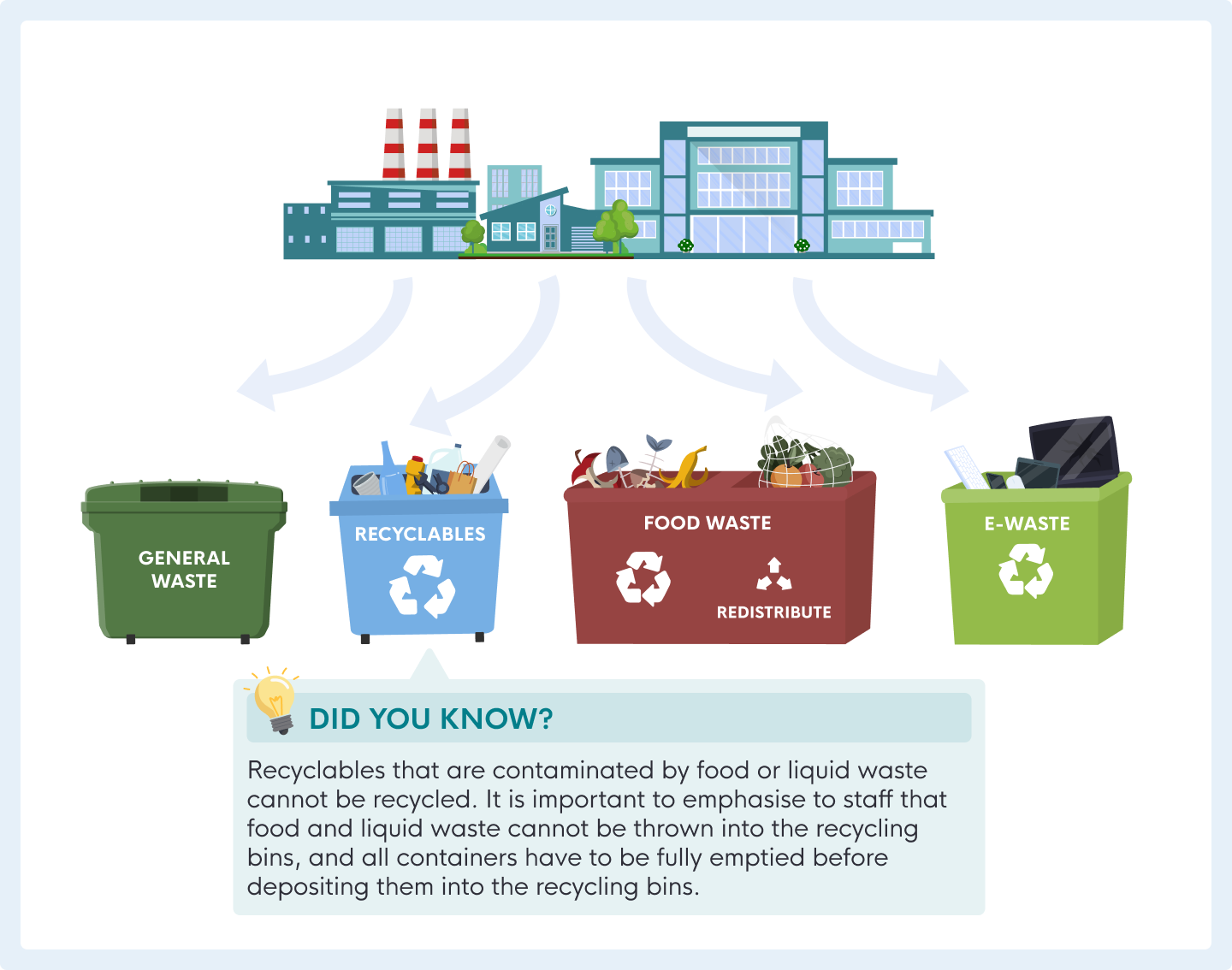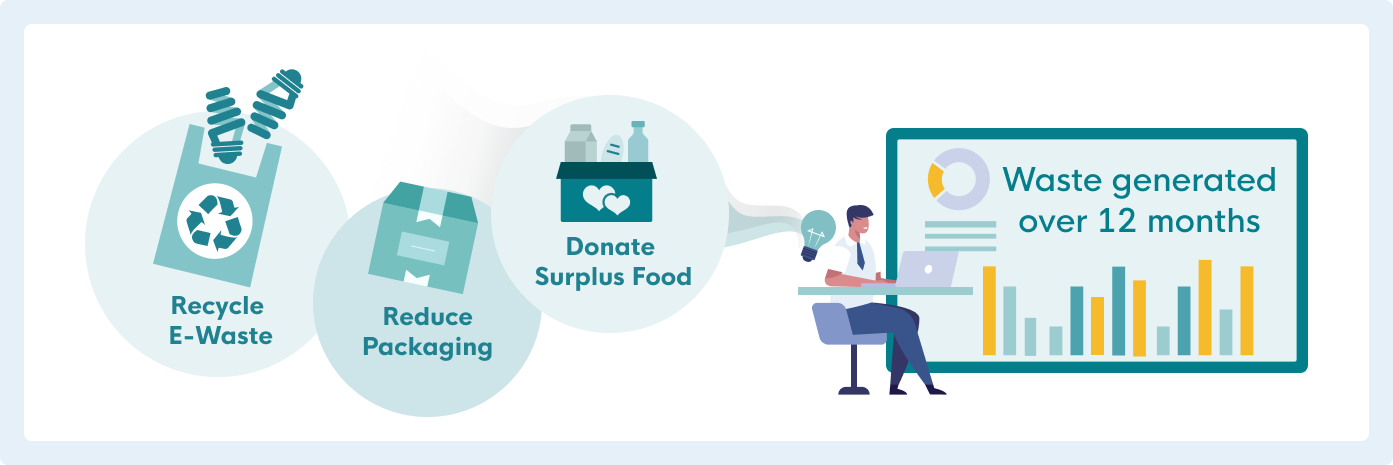- SME Sustainability Hub
- Sustainability Topics
- Waste Management
- Stage 2: Measure
Stage 2 (MEASURE): Identify relevant areas for first-step interventions
Analyse your waste profile, establish a baseline and identify waste generation patterns and opportunities for improvement.
In this page:
2.1 Pinpointing waste generation
Segregating your waste and collecting data are key processes that will help you understand how resource efficiency can be improved for your operations. Waste data is also increasingly required by regulators and stakeholders, making it important for businesses to embark on waste management efforts.
Step 1: Get to know your waste profile
It is important to place dedicated bins in appropriate locations for staff to conveniently separate recyclables from the rest of their waste. When waste is not segregated properly, recyclable waste can be contaminated and disrupt the recycling system1.

- Recyclables: Recyclables are categorised by the four main types: papers, plastics, metals and glass. Refer to the NEA website for more information on the categorisation of recyclables.
- E-waste: E-waste should be segregated and recycled appropriately. Refer to the NEA website to find out what type of e-waste can be collected and how it should be sorted.
- Food Waste: The best way to manage food waste is to avoid over-production or over-ordering of food at the onset. This can be done by developing better estimates of the amount of food that will be consumed. Where there is unsold or excess food, food can be redistributed as an avenue to avoid food wastage. Lastly, food that cannot be redistributed should then be valorised or treated where possible. Valorisation is the treatment of food waste into high-value add products such as those that could contribute back to the food cycle.
-
Since 1 January 2021, developers of new commercial and industrial buildings that generate large amounts of food waste must allocate space for on-site food waste treatment systems in their design plans.
-
The food waste segregation, treatment and reporting requirements for new buildings has commenced on 8 March 2024. For existing buildings, the requirements will commence progressively, in tandem with the phased completion of the food waste treatment facility at Tuas Nexus.
- While there are no mandatory requirements, businesses are encouraged to use SS EN 840 certified Mobile Garbage Bins (MGBs) and plastic receptacles to facilitate the segregation and collection of food waste.2
-

TIP:
Not all food-related items can be processed as food waste. For instance, food by-products such as hard shells, dough, sugar cane bagasse, as well as common packaging materials such as glass, metal and plastics, cannot be processed as food waste. Refer to the NEA website to find out more on what types of food can be treated.

Step 2: Collect waste data and set a baseline year
To effectively manage and reduce your waste generated, it's essential to establish a baseline to start tracking your waste generation. This will serve as a benchmark to gauge progress and set targets. To set a baseline, you should select a year that is representative of your typical waste generated, and is free from any anomalies that might skew your data.
- Businesses should start by having a system to collect and record waste data. You can consider the following options based on applicability to your operations3:
- Option 1: Obtain all weighbridge tickets / receipts by General Waste Collectors (GWCs) showing the weight of waste disposed from your premise
- Option 2: Adopt one of the methods below to weigh and record your waste:
- 2a. Engage GWCs with trucks fitted with weighing systems and obtain tickets / records generated by the truck's weighing system to track the amount of waste collected for every collection trip.
- 2b. Acquire weighing scales with less than 5% error margin to perform in-house weighing and maintain all weighing records.
- After collecting waste data from the past year, input this data into a spreadsheet to visualise your waste generation patterns.
- After organising your waste data into a manageable format, calculate your annual waste generation and waste recycled.

Take it one step further and conduct a waste audit
Businesses with complex waste streams, such as those in manufacturing, can consider conducting a waste audit. Waste audits involve a structured assessment process to quantify the sources, volumes and types of waste generated within a facility. The specific information gathered will typically include:
- Types of waste
- Quantity of each waste type
- How they are generated
- Why they are generated
- Where they are generated
- How they are managed after being generated
Findings from a waste audit will help to uncover opportunities to reduce, reuse or recycle waste materials, as well as provide baseline data to gauge the effectiveness of a 3R programme.
SMEs in the industrial development and hospitality sectors can view the following NEA guidebooks to find out more details on how to conduct a waste audit:
Step 3: Identify waste generation patterns and opportunities for improvement
After you have established a robust waste data collection process, you can review monthly data to identify patterns and fluctuations that might provide insights on how you can reduce waste generated.

1 National Environment Agency, '3R Guidebook for Offices'
2 National Environment Agency, 'Food Waste Segregation and Treatment Guidebook', (May 2020)
3 National Environment Agency, 'Mandatory Waste Reporting', (28 Aug 2024)